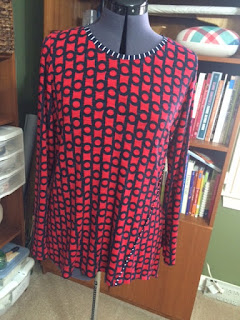It is fun to sew for granddaughters, especially if you do so before they become too opinionated and too dependent on cheap fashion. Three times a year I have an opportunity to sew for my sweet girls on their birthdays. It is great fun for me and I love seeing them in my makes. But they are all old enough now to have clothing opinions and I have to respect that.
Can you tell I've been burned a few times?
This time I chose Butterick 5877, a sweet and somewhat modern pattern, appropriate for a 10-year-old. This is an age-group with few options in the Big 4 pattern companies. Most styles are too young and too small, or too old and too curvy.
I guess I have become spoiled with great instructions from independent pattern makers like The Sewing Workshop and Cutting Line Designs. And Vogue typically has pretty good instructions. I was disappointed in this set of instructions. It is labeled Easy and it could be easy with better instructions. It did not slow me down but I wondered how it might affect a new sewer.
The skirt is completely circular (love that!) and the bodice is pretty straight across the high waistline, so you have to sew a curve to a straight line. My first make was in a woven printed cotton, nice stable stuff, really easy to sew. The instructions are these:
Pin upper edge of skirt to lower edge of bodice matching seams and centers. Stitch.
Can we say just a little more, Butterick Patterns? Perhaps this: Stay-stitch along the seam line of the skirt and clip so that it will fit the bodice seam. Then match notches, seams and centers, pin and stitch.
They even define stay-stitching in their plug-in glossary but never, ever use it in the instructions. OK. Enough whining. I actually had a blast making this.
The print is a piece Hannah selected a year or so ago. It has little gold flecks in it and I was not crazy about it. But I like now.
The pattern calls for a buttons in the back of the bodice. Knowing how chaotic DD's life is and how difficult it is button yourself up in the back, I opted for a zipper instead.
The cropped leggings are a cotton knit, super easy to make. I can visualize Hannah running around the neighborhood in this ensemble, with her skirt flying. She does this.
 |
| She loves these buttons! |
The second one is very plain. I used the longer skirt so that it is a dress, rather than a tunic. Because the jersey knit was wide, I was able to cut the skirt without any seams - just a circle with a little waistline hole. I used a striped cotton shirting to add a bit of weight to the hem.
Because it is so plain, I have asked Hannah to come up with some ways to take it up a notch. This is something we've done with other plain dresses. She likes to sketch and I'm hoping she'll come up with some applique ideas.
And now, it's back to selfish sewing.



































































